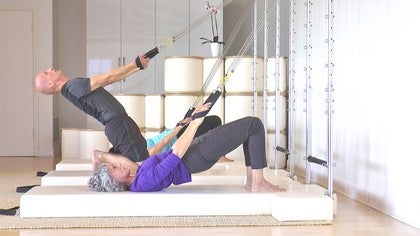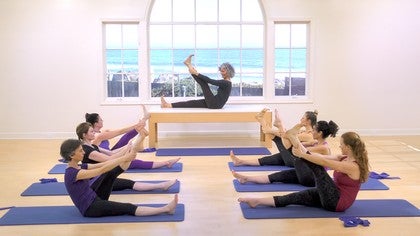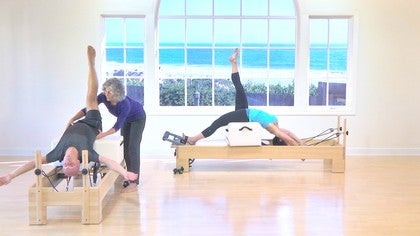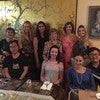Description
Wendy's "playmates" are PA members Heikki Lempiäinen and Jennifer Weiss.
About This Video
Transcript
Read Full Transcript
So welcome back. It's wonderful to be with you again. And I have a special treat for you because what we're doing today is playing, and this was very much the way I see the Joseph Pilati is allowed himself to play. If you look at Mary Bowen's films, you can look on her website and she has this fabulous archival films of Joseph Wattis playing in the woods and going down and going up and doing bear walks and, and, and squats and all sorts of things tumbles and, and how are we using the springs to allow ourselves to open to play? And that's really what the Fascia, when connective tissue and Fatia supports muscles, bones, organs, what vessels, and that's all supported by the connective tissue body. You'll notice that everything moves so freely and so beautifully. So that's what we're doing. And HCA and Jennifer are with me today, which I'm so grateful for.
And you'll see that we're each going to be doing what feels good to our bodies. Even as I'm, this is really a a tuneup I think of, you know, the body genius that we're so aware of, but often we don't treat ourselves as body genius and when we do, we get so much more because our body becomes our best friend and that's what we're doing. We're really playfully awakening that, that genius, and I'm going to play here with them and also then I'll share some other things with you because you'll see how we'll be able to go to deeper places in some other, some other ways. Well, what you'll notice is that we're playing with arms springs
Now what allows me to come up one vertebra at a time is just feel the spring, feel your spine releasing the shoulder blades releasing down and it naturally lifts my head. Notice my throat is not gripping so I can still talk. That tells you if you're able to talk. As you roll up and down and don't feel your throat inhibited, you know that your throat is open and your spine is more released. So we're playing with gravity, playing with the elbow, releasing back as my other arm releases forward.
Noticing each side has its own uniqueness. There's not a right way to do this. There's just sensing. You're just sensing and right there. Now here's the impulse. You allow the shoulder blades to release down, allow the hips to be heavy and that's what brings your legs in. Is there like see your muscles and connective tissue begin to be like springs?
Your joints begin to be like springs. All I'm doing is pressing down gently into the spring and that's allowing my legs to go over forever. Just feeling it. Now I'm giving it a little more down into my shoulders and my shoulder blades and that creates lift. Still no tension in by throat. As my legs go up and all I'm doing is allowing my back to open.
Notice how we're all playing, just doing what feels good. The down gives me lift. How can a teaser be so light and lifted? See Opening, circling, playing. Now with the bridge, what's so fun is where do you feet want to live in order to lift your hips? If your feet are too far away, this is the way to just notice what creates more support.
If your feet are too far away, I have to use a little gripping to lift my hips when my feet are in a place. As I press down into my feet, all of a sudden my tail just lifts with no effort and all I've done is just released into gravity. Gravity is a partner and now I'm reaching through each knee, pressing to the right foot, pressing through the left foot, playing. Each side can feel the release all the way down, and then you can just do that over and over again. You just do what feels good, do what feels good to your body, and now we'll do a little bit of a spiral, so I'm pressing into the left foot to spiral over to the left. You can even take it. You can go deeper and deeper and deeper. You see where you want to go, what feels good to your shoulders, what allows your body to open?
How can that internal and external rotation feel good to your shoulder? And then as you roll over, you go to the other side, spiraling. Oh over. See, I'm just allowing my knee to release and letting my left arm release into the spring, and that's just taking me deeper into the spiral. Notice if you turn your head, that takes you even deeper into a release in your spine. It's all about a conversation with your body rather than doing something to your body. Very, very different feeling. And then coming up you can press down to stand up and just like kick it was playing with a moment ago, feeling squats, how important it is to feel a squat, to feel where you can be that allows the down this, this totally opens up sacral pain and up.
How are your feet opening as you squat, play with rotation of your shoulders as you squat so you feel how, what is it that allows you to feel more down the back, up the front, playing, playing, playing. Ah, walking forward. Really?
That same release down and here just gently roll over and notice I'm just allowing my leg and just remember to go only as far as it feels good to you. Now my body right here and my foot is just responding to what is going to allow me to come off the mat. Oh, bedding up. And you'd be sure to do what feels good to your shoulders. What feels good to your spine? Remember, this is not a performance.
This isn't about who's doing what. This is about feeling good. This is about exploring and sensing what your body wants. Asking it. We're asking, we're not telling, feeling that lift, opening up, Eh, release. And now from here we're going to take a look at what if you don't have a Cadillac, that's fun too. So you don't have a tower, you don't have a Cadillac, but you really want to get in touch with that. How do I relate to gravity? How do I feel that? Well, how can a theraband be like a spring?
So remember in our exploration of what we're doing, we're looking at what is it that allows the body to feel it's natural.
Feel that play with each foot to each hand. See what feels good to you. Play with your head in relationship to your foot. I'm just making this up. By the way. I have not practiced this, at least this particular version. Okay, and then from there, how do we play with, you know, we've all done the roll up with a theraband, but how do we allow, where do you hold it? Hold it rather than holding it and gripping.
How do you hold the theraband so there's no effort? As you release to the Mat, your shoulders lie down, your neck lengthens, you feel, oh [inaudible] floating, creating space in your body. How do we press out and open? Let it open up and down. Put the band behind your back. Press Up, feel the waterfall, the shoulder blades down your back as you press into your feet and float your hips.
This is an amazing movement, by the way. This is really core coordination because I'm looking, I'm, I'm really sensing how my neck just got very, very free. Really, because my waterfall down in the back is now talking to the internal lift up the front. You can see how it's open. Fun. And from here, what's just enough? Press out. What's just enough that allows lift to happen?
Feel the down. Give you lift, opening, playing. Doesn't matter. You're just playing with gravity. Playing with Lyft. From here. Play with the spiral.
Feel the waterfall, the shoulder blade down your back. Oh, the font, shoulder blade down the back. Internal. Lift up the front. So how has your hand goes up? That's why you want to look at how tight is your therapy. And if it's too tight and your shoulder goes up, let it go.
Let the waterfall drop. Feel your internal lift up. How does that completely take you into a restorative, regenerative way of being with yourself? It just opens everything. It's not about training ourselves. It's about opening to awareness, opening to enlivening, and just loving life. So have fun. See you next time. Bye.
Mindful Movement: The Brilliance of Your Biointelligent Body
Comments
By the way, congratulations, Gary, on your pivotal role in the beautiful movie "A Movement of Movement" which I just saw at the 2013 PMA Annual Meeting in Ft Lauderdale!
thank you
You need to be a subscriber to post a comment.
Please Log In or Create an Account to start your free trial.



















